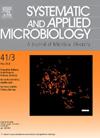Acidimicrobiia, the actinomycetota of coastal marine sediments: Abundance, taxonomy and genomic potential
IF 4.2
2区 生物学
Q2 BIOTECHNOLOGY & APPLIED MICROBIOLOGY
引用次数: 0
Abstract
Microbial communities in marine sediments represent some of the densest and most diverse biological communities known, with up to a billion cells and thousands of species per milliliter. Among this taxonomic diversity, the class Acidimicrobiia, within the phylum Actinomycetota, stands out for its consistent presence, yet its limited taxonomic understanding obscures its ecological role. We used metagenome-assembled genomes from a 5-year Arctic fjord sampling campaign and compared them to publicly available Acidimicrobiia genomes using 16S rRNA gene and whole-genome phylogenies, alongside gene prediction and annotation to study their taxonomy and genomic potential. Overall, we provide a taxonomic overview of the class Acidimicrobiia and show its significant prevalence in Isfjorden and Helgoland coastal sediments, representing over 90% of Actinomycetota 16S rRNA gene sequences, and 3–7% of Bacteria. We propose Benthobacter isfjordensis gen. nov., sp. nov., Hadalibacter litoralis gen. nov., sp. nov., and two new species from Ilumatobacter, following SeqCode guidelines. In addition, we report the first in situ quantification of the family Ilumatobacteraceae, revealing its substantial presence (1–6%) in coastal sediments. This work highlights the need of refining the taxonomy of Acidimicrobiia to better understand their ecological contributions.
酸性微生物,沿海海洋沉积物中的放线菌群:丰度、分类和基因组潜力。
海洋沉积物中的微生物群落是已知密度最高、种类最丰富的生物群落,每毫升中含有多达十亿个细胞和数千个物种。在这种分类多样性中,放线菌门(Actinomycetota)中的酸性微生物(Acidimicrobiia)类因其持续存在而脱颖而出,但对其分类的有限了解却掩盖了其生态作用。我们使用了为期 5 年的北极峡湾采样活动中的元基因组组装基因组,并使用 16S rRNA 基因和全基因组系统进化、基因预测和注释将其与公开的 Acidimicrobiia 基因组进行了比较,以研究其分类学和基因组潜力。总之,我们对酸性微生物类进行了分类概述,并显示了其在伊斯菲尤登和赫尔戈兰沿海沉积物中的显著分布,占放线菌16S rRNA基因序列的90%以上,占细菌的3-7%。根据 SeqCode 准则,我们提出了 Benthobacter isfjordensis gen.此外,我们还首次报告了 Ilumatobacteraceae 科的原位定量,揭示了其在沿海沉积物中的大量存在(1-6%)。这项工作强调了完善酸性微生物分类的必要性,以便更好地了解它们对生态的贡献。
本文章由计算机程序翻译,如有差异,请以英文原文为准。
求助全文
约1分钟内获得全文
求助全文
来源期刊

Systematic and applied microbiology
生物-生物工程与应用微生物
CiteScore
7.50
自引率
5.90%
发文量
57
审稿时长
22 days
期刊介绍:
Systematic and Applied Microbiology deals with various aspects of microbial diversity and systematics of prokaryotes. It focuses on Bacteria and Archaea; eukaryotic microorganisms will only be considered in rare cases. The journal perceives a broad understanding of microbial diversity and encourages the submission of manuscripts from the following branches of microbiology:
 求助内容:
求助内容: 应助结果提醒方式:
应助结果提醒方式:


